Discover the rich history and cultural significance of Himeji Castle, also known as the White Heron Castle. It is the largest, most renowned castle, and one of the 12 original castles still left in Japan.
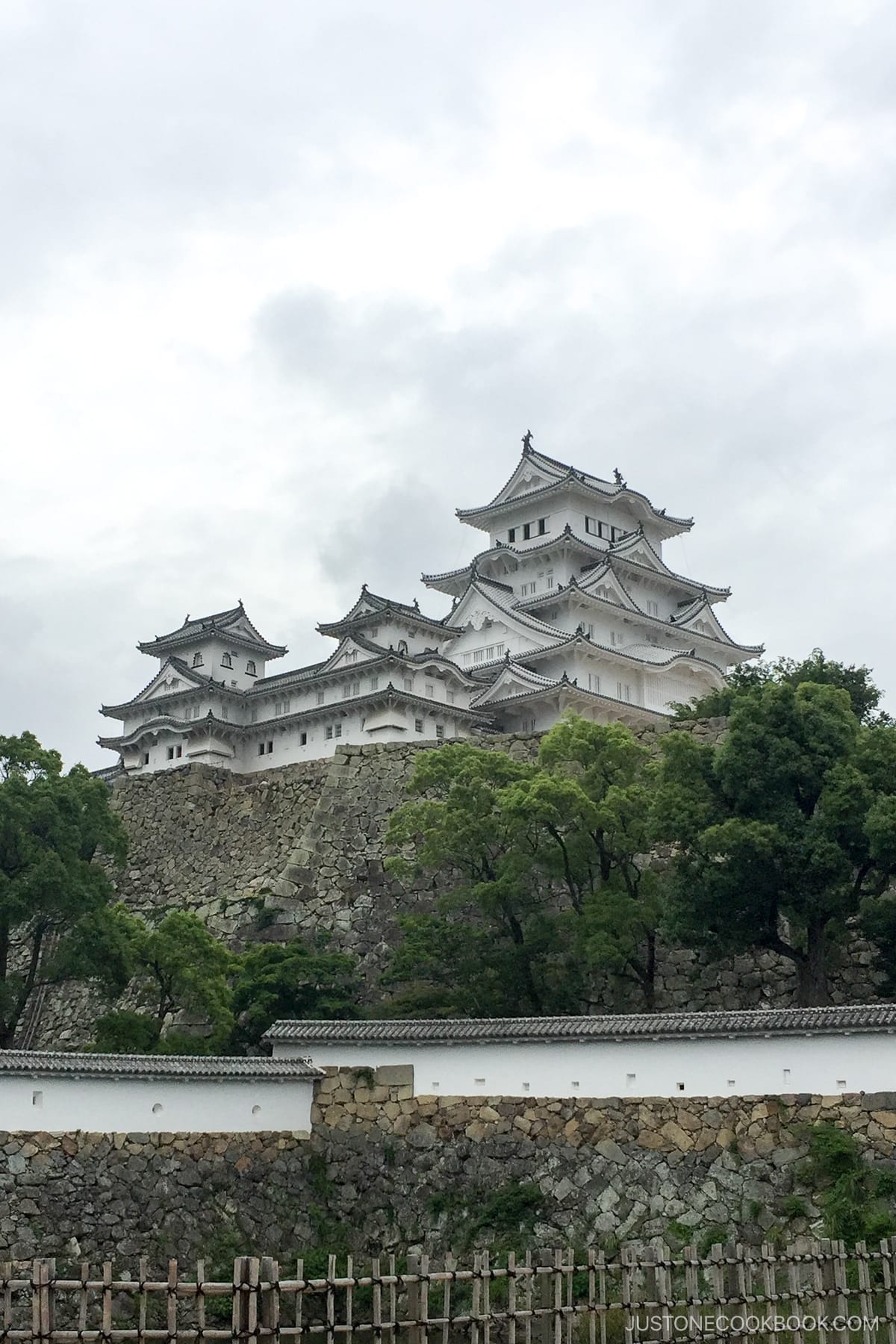
My family loves visiting Japanese Castles. With each visit, we get to learn more about the deep history and fascinating stories that surround these remarkable structures. Standing in awe before their grandeur, I can’t help but envision the bygone eras of feudal lords and shoguns who once inhabited these very grounds.
Today, I will share with you our family’s memorable visit to Himeji Castle, which I hope will inspire you to include it as one of your stops in Japan!
Table of Contents
Remaining Original Japanese Castles
Almost all of the 200 castles you see in Japan today are merely replicas. Numerous originals fell victim to the ravages of fires, wars, and earthquakes. Remarkably, only a dozen original castles endure, standing as enduring symbols of Japan’s rich heritage and architectural splendor.
- Bitchū Matsuyama Castle
- Hikone Castle
- Himeji Castle
- Hirosaki Castle
- Inuyama Castle
- Kōchi Castle
- Marugame Castle
- Maruoka Castle
- Matsue Castle
- Matsumoto Castle
- Matsuyama Castle (Iyo)
- Uwajima Castle
Among the original castles, the grandest of them all is the Himeji Castle in Hyōgo Prefecture. It is considered one of Japan’s three premiere castles along with Matsumoto Castle and Kumamoto Castle.
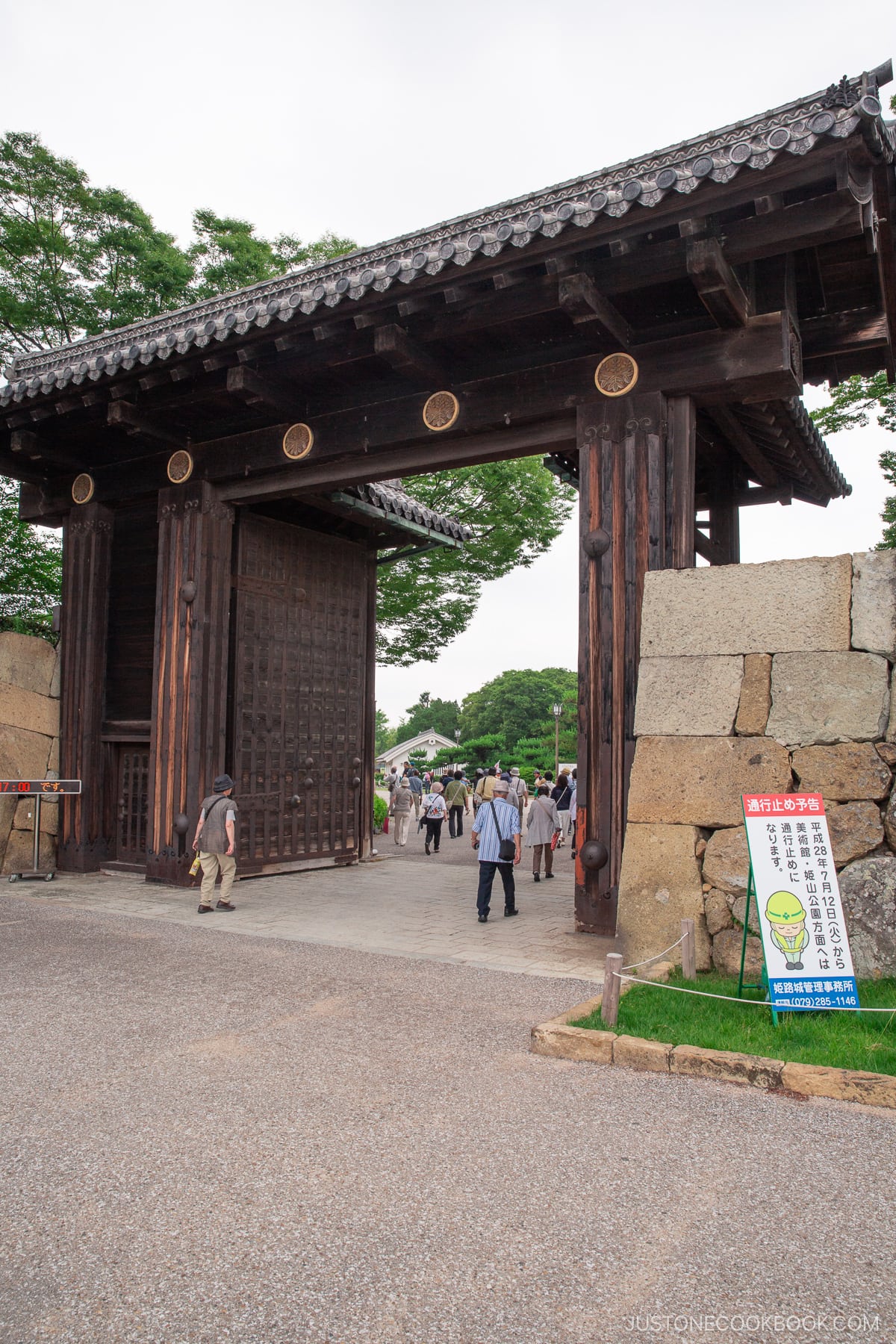
How to get to Himeji Castle
Himeji Castle, located in Himeji City, is easily accessible by either Shinkansen or Shinkaisoku 新快速 (Special Rapid Service Train). If you are already in the Kansai area, you can reach Himeji Station in 40 minutes from Kobe, one hour from Osaka Station using the Shinkaisoku, and one hour and 15 minutes from Kyoto Station. It’s close enough for a day trip if Himeji Castle is on your itinerary. If you take the Shinkansen, Himeji Station is only 30 minutes from Shin-kobe station.
When you arrive, you can see the majestic castle just down the road from the train station. You can either walk to the castle in about 15 minutes or take the bus. Buses depart every 5-7 min from the train station that will conveniently stop near the castle.
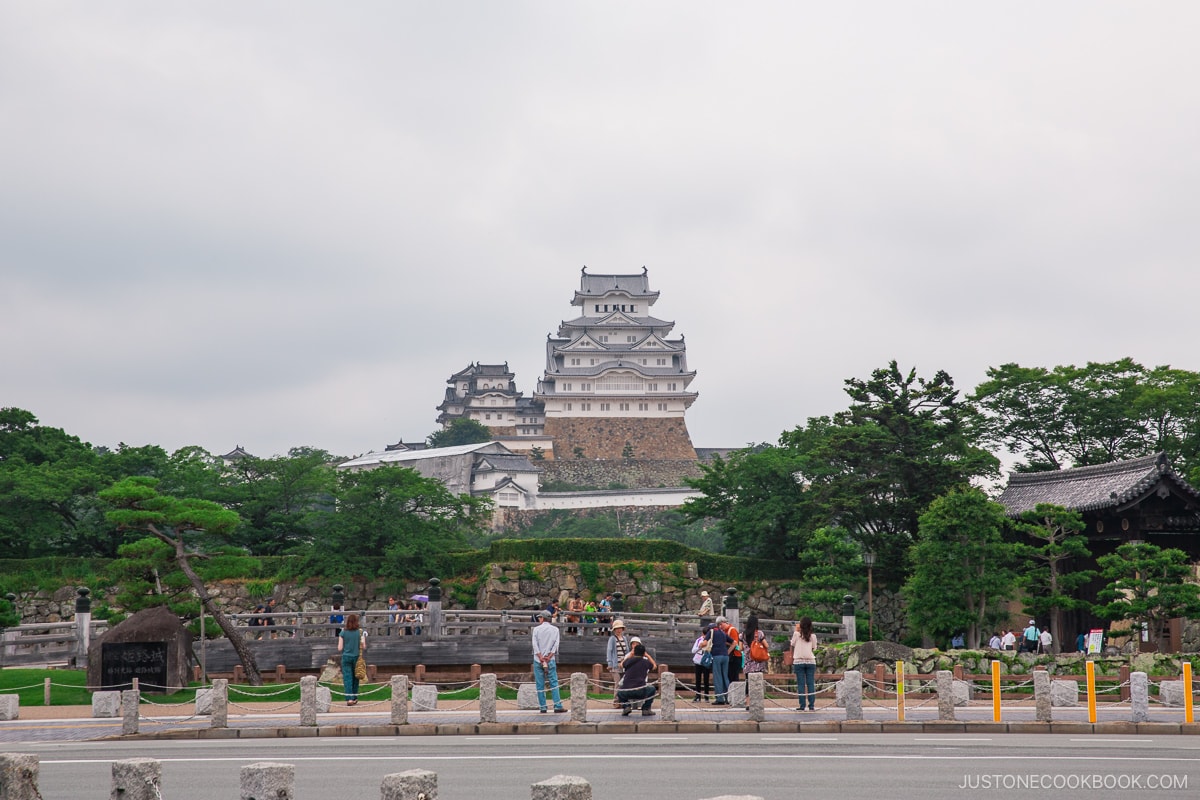
History Of Himeji Castle
Dating back to the early 1600s, the current structure of Himeji Castle underwent extensive renovation and restoration, leading to its reopening to the public in March 2015. The site on which Himeji Castle lies dates back to 1333 when it served as a seat of power for rulers.
Besides being the largest and most visited castle, it is also one of the first Japanese UNESCO World Heritage Sites. Himeji Castle is an exemplary showcase of traditional Japanese castle architecture, boasting many advanced defensive systems and features from the Feudal Period (1185-1603).
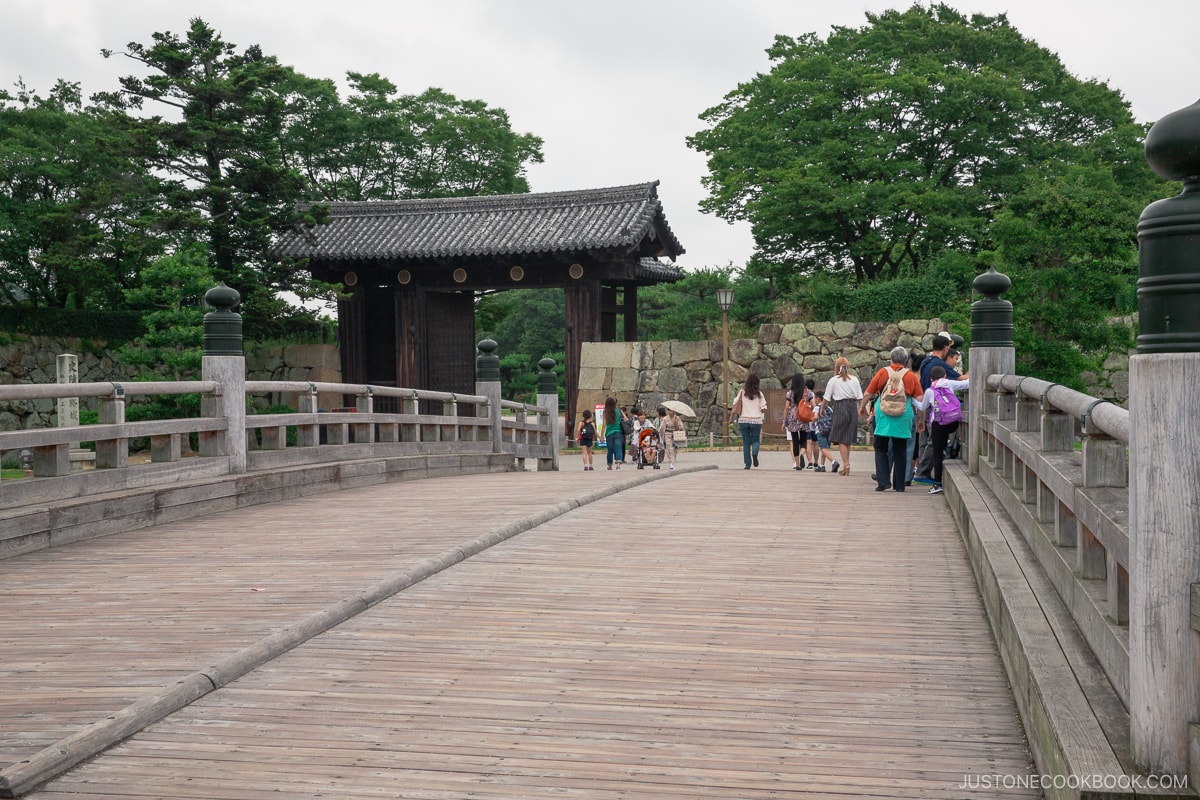
As you cross Sakuramon Bridge (桜門橋) through Otemon Gate (大手門), you can enjoy walking around the castle grounds at no cost.
Himeji Castle Nickname
Himeji Castle is also known as Shirasagijo (白鷺城) or “White Heron Castle” due to its white exterior, resembling a bird in flight. Its elegant appearance and grand stature attract millions of visitors every year, with the peak season during cherry blossom season. From late March to mid-April, over 1,000 ephemeral cherry blossom trees surround the castle complex, creating a magical scene of pink and white.
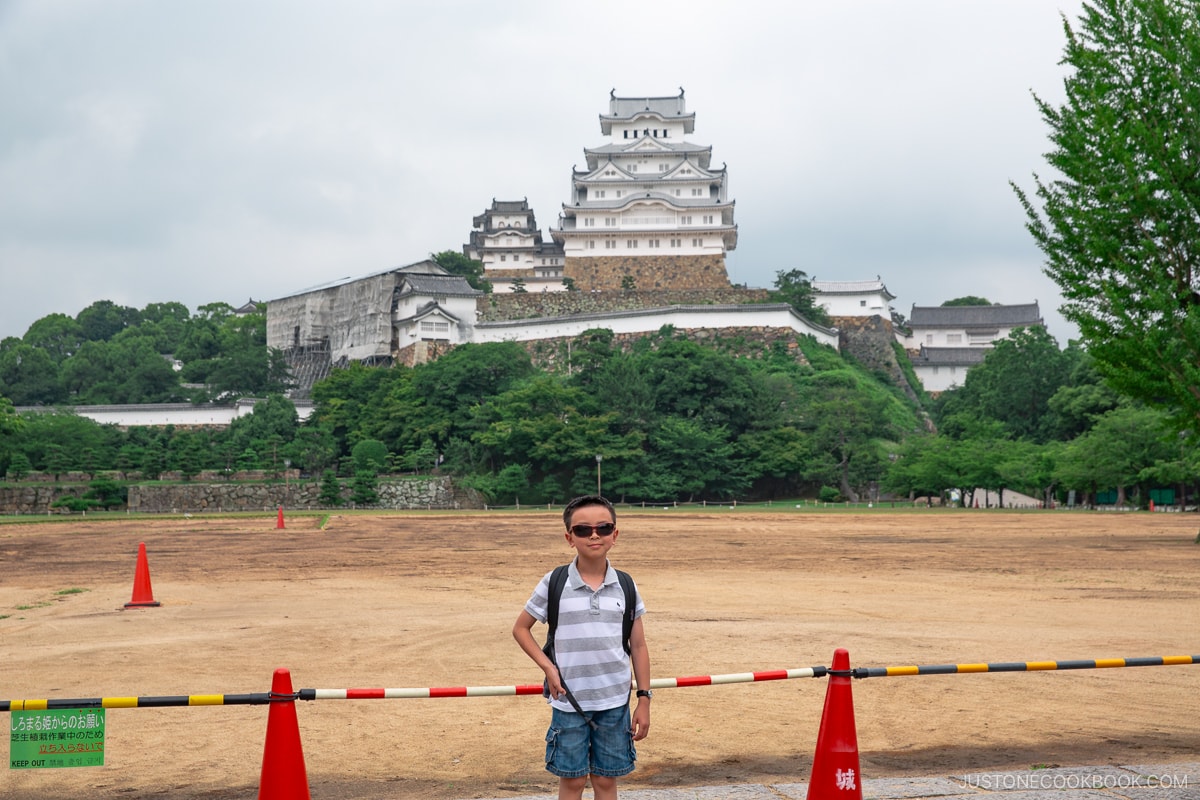
Tour of Himeji Castle
Before entering Himeji Castle, you will need to purchase tickets from the vending machines. Entrance fees are ¥1,000 for adults and ¥300 for all school children (prices in 2024).
Himeji Castle is built on a hilltop (Himeyama), so there is quite a bit of climbing involved as the castle’s stairs are quite steep – a word of caution to those who might have trouble climbing or walking for long periods.
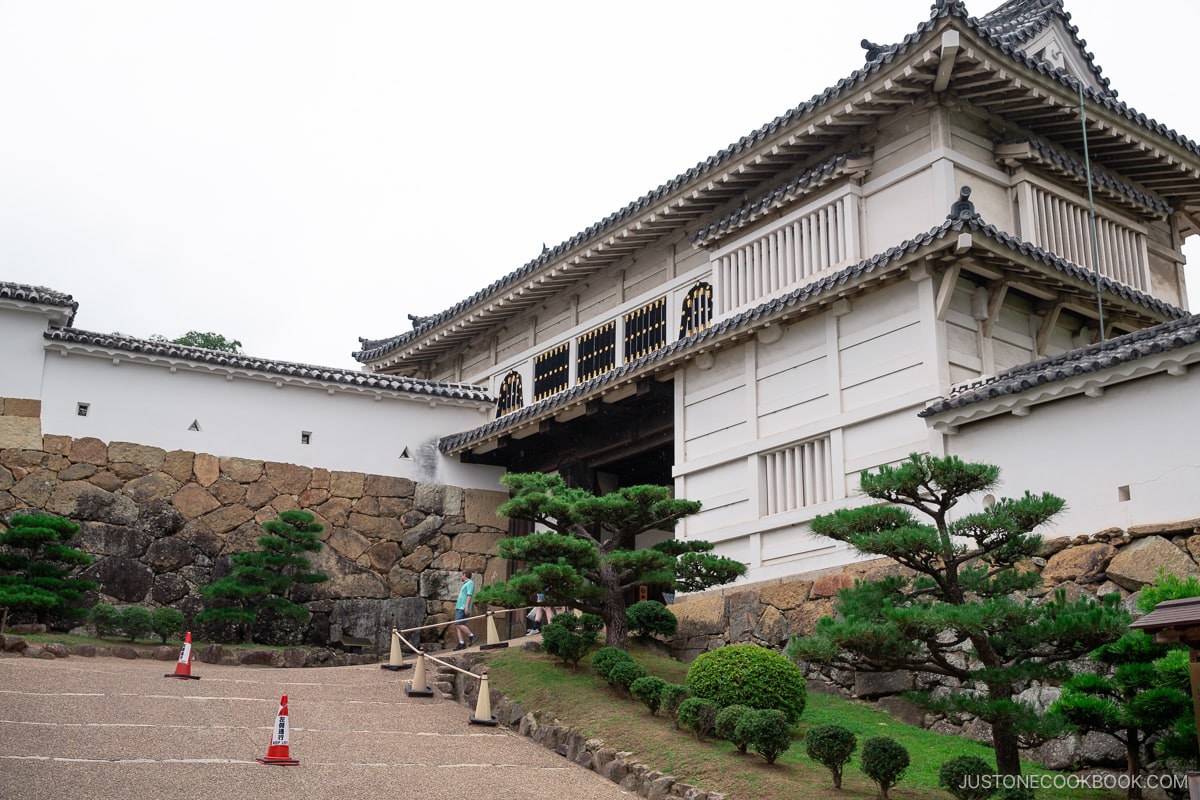
The paths and walkways up to the castle are intentionally designed like a maze, intended to confuse the enemy during attacks. In addition to their complexity, these paths are very narrow and steep, making them even harder to navigate.
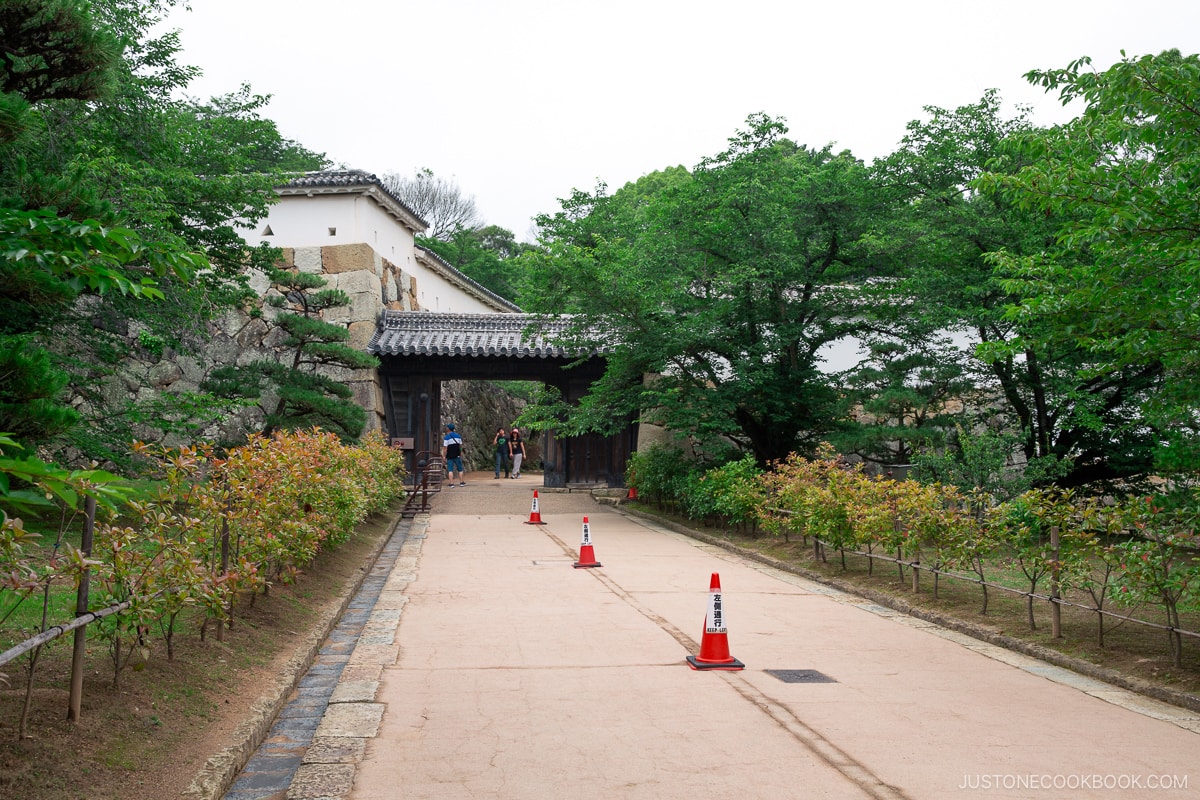
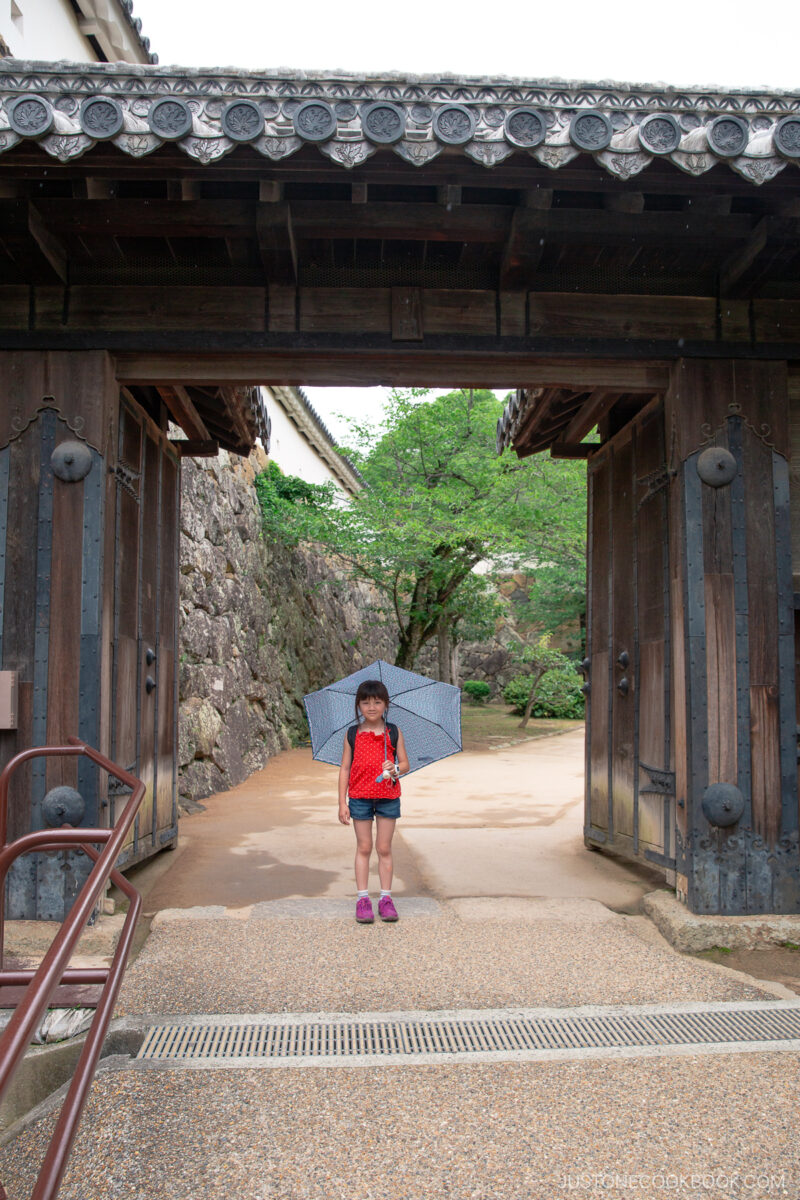
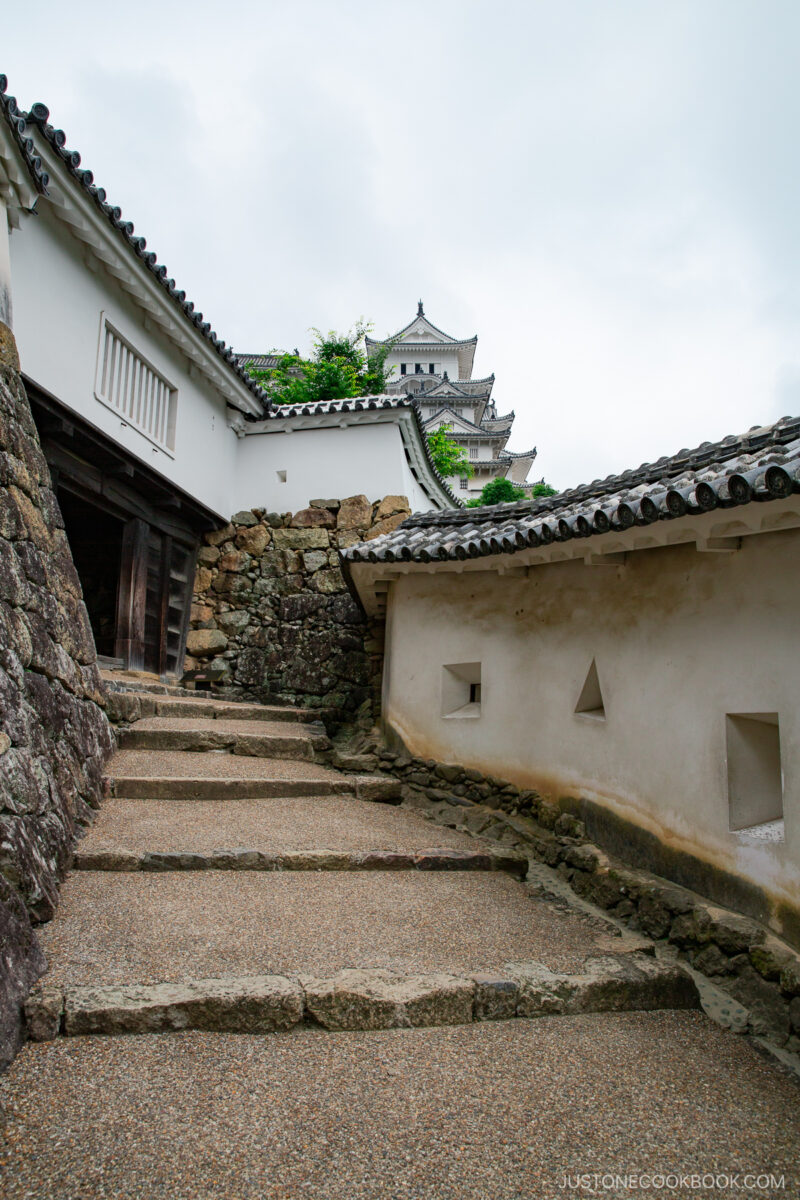
As you can see in the photo below, many gates leading to Himeji Castle Tower are very small, which is part of the castle’s defense feature. It would be difficult for more than a few adults (or an army) to enter quickly.
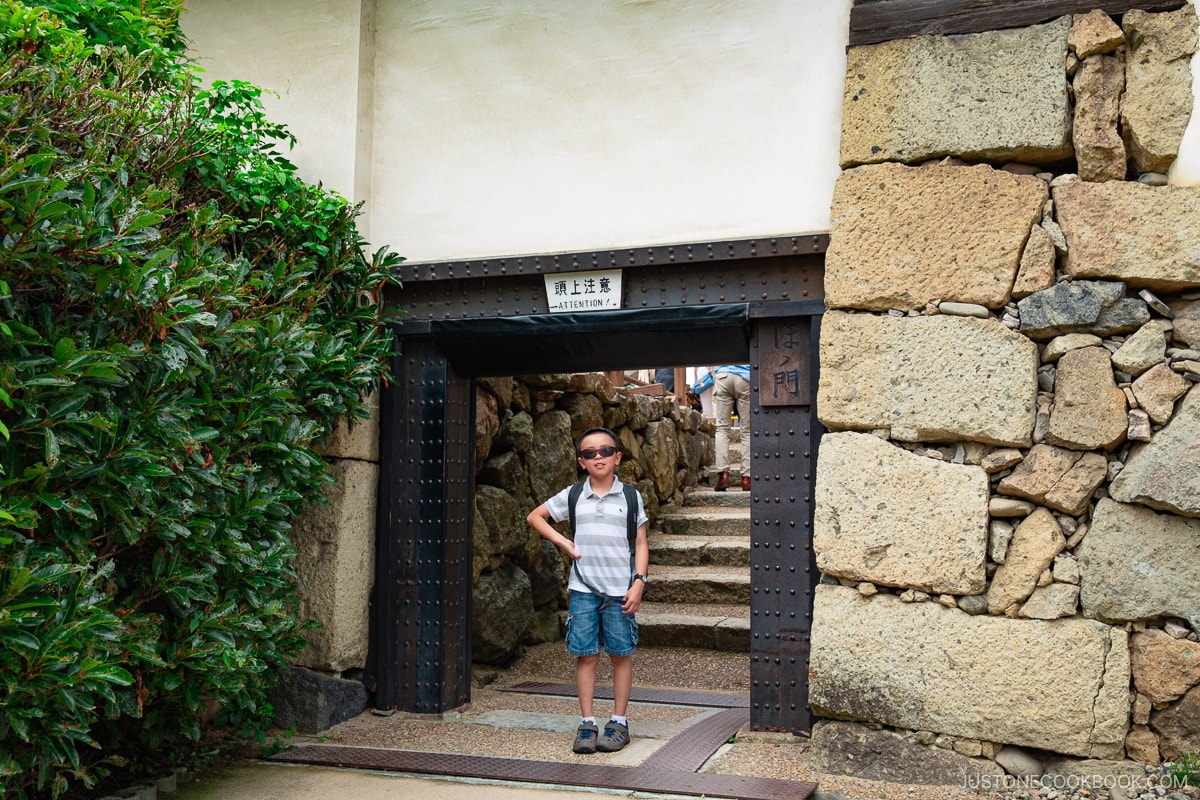
The various gates act as barriers and the high stone walls make it difficult for any potential invader to pass through before reaching the main keep.
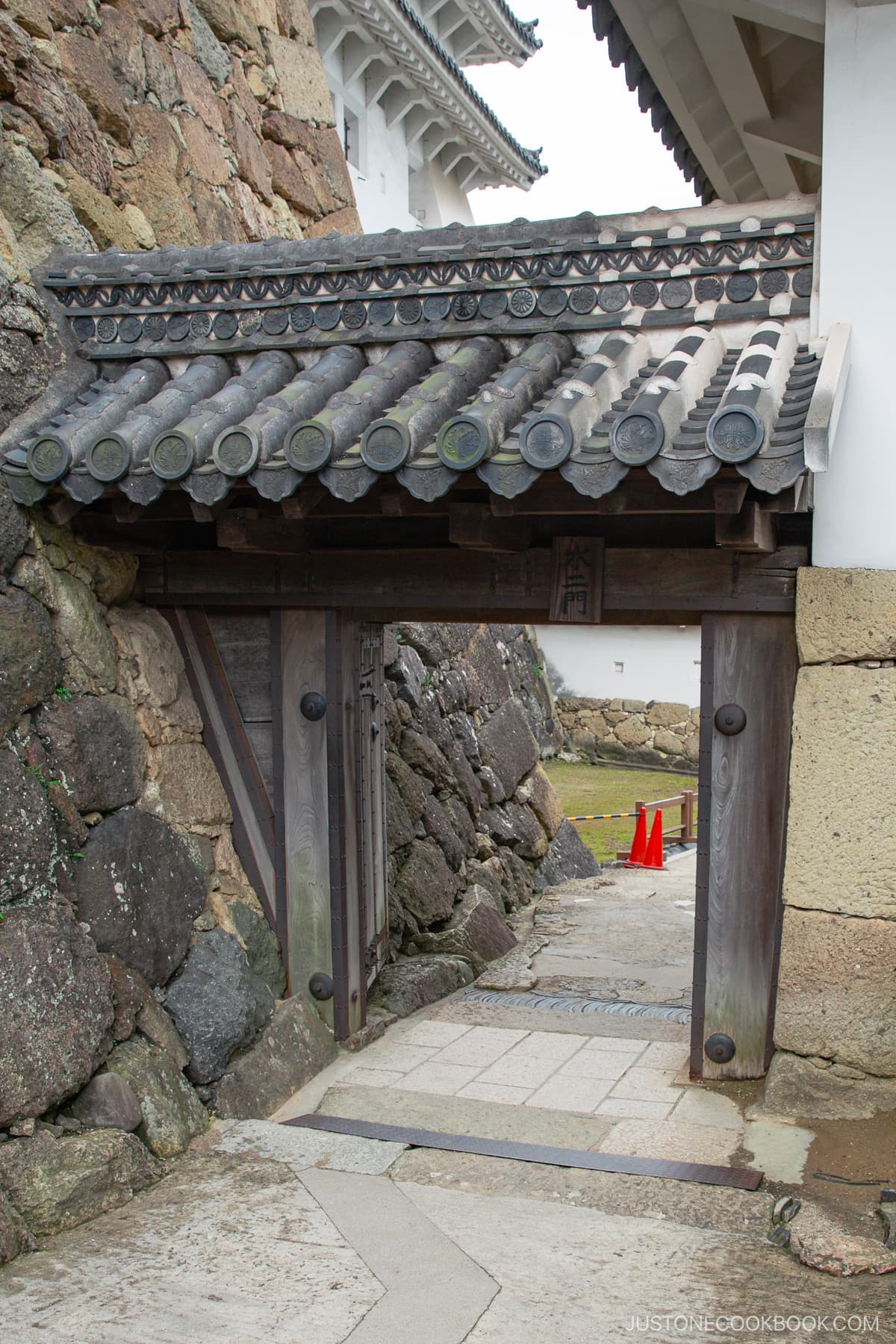
Throughout the tour, plaques explain the purposes of specific architectural characteristics. In this example, it explains the history of the Oil Wall.
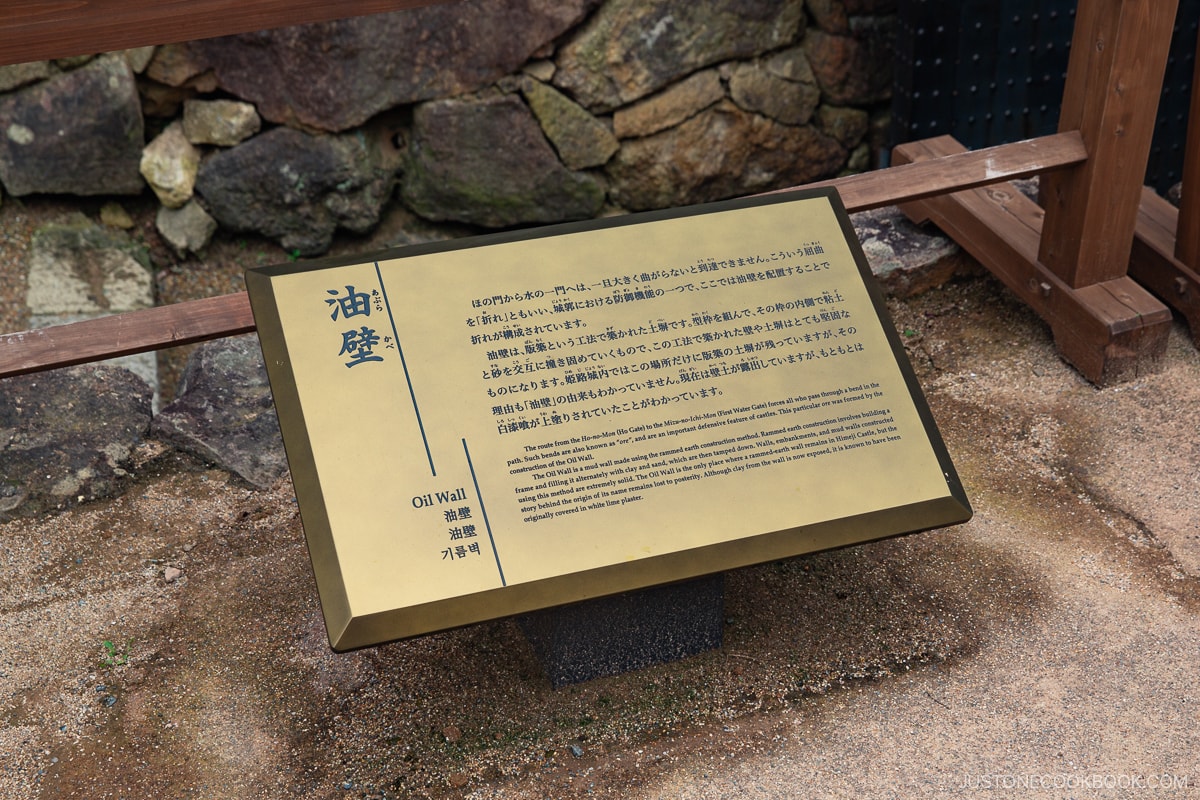
The oil wall is a mud wall made using a rammed-earth construction method, resulting in a very strong structure. It is the only rammed-earth wall remaining at the castle and was originally covered in white lime plaster.
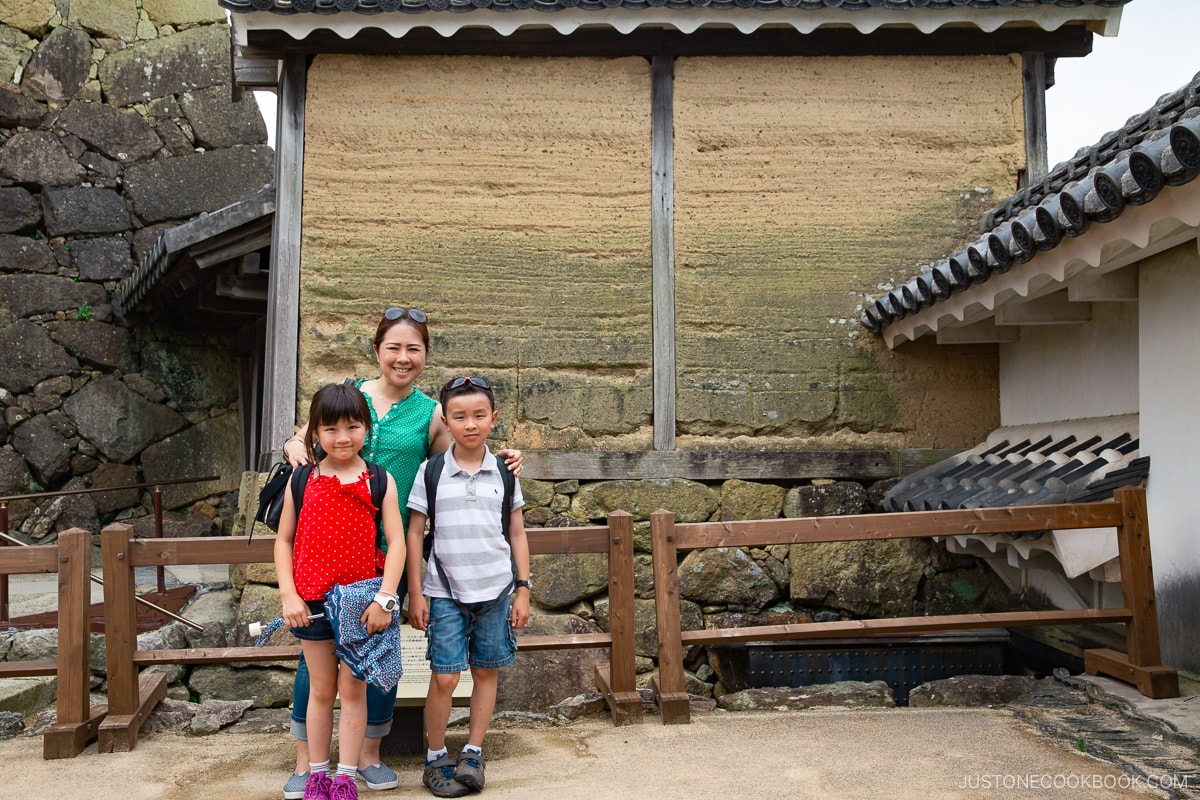
The Himeji Castle Tower
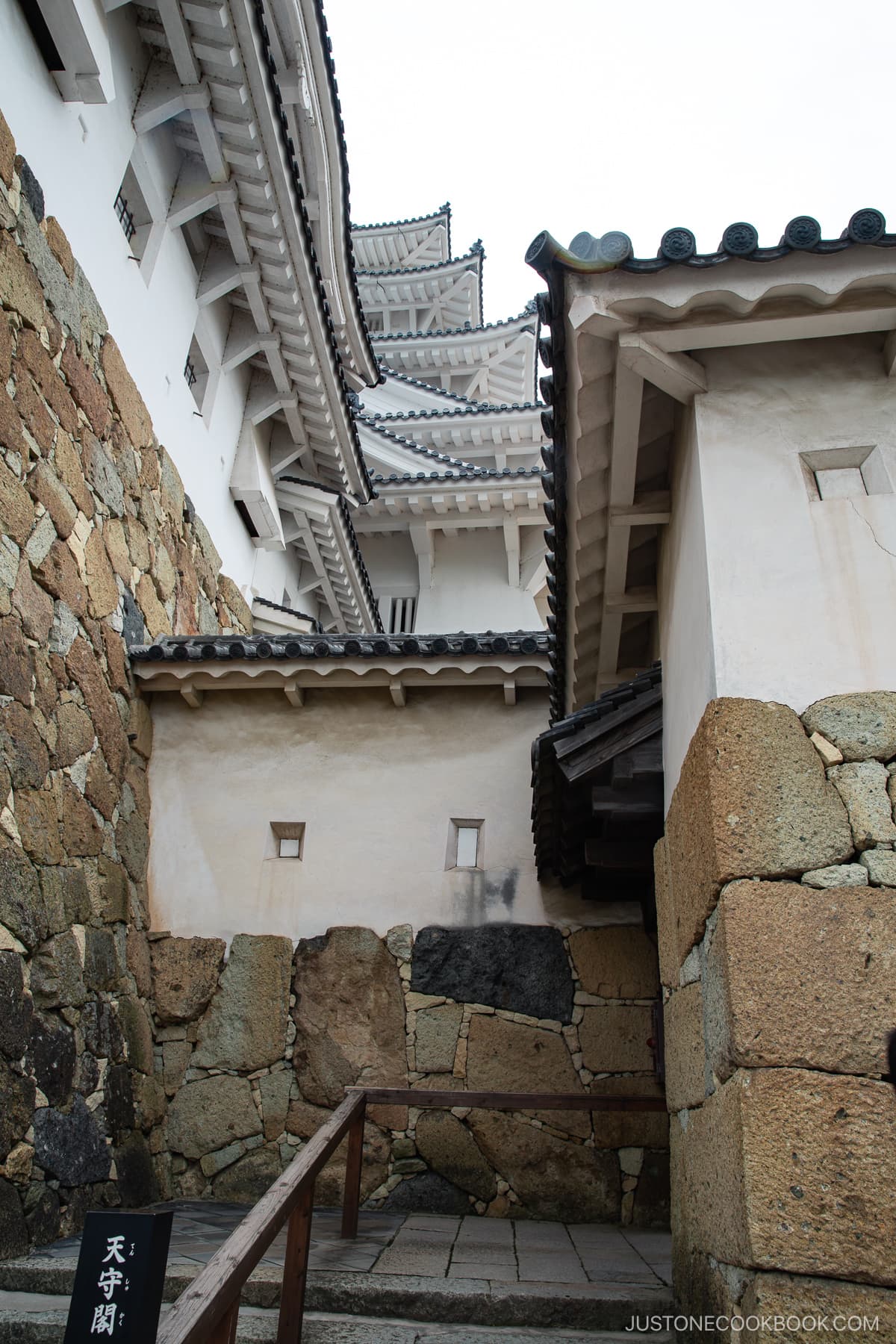
After entering the main keep, there is a model depicting the Himeji Castle and the surrounding area during the feudal days on the first floor.
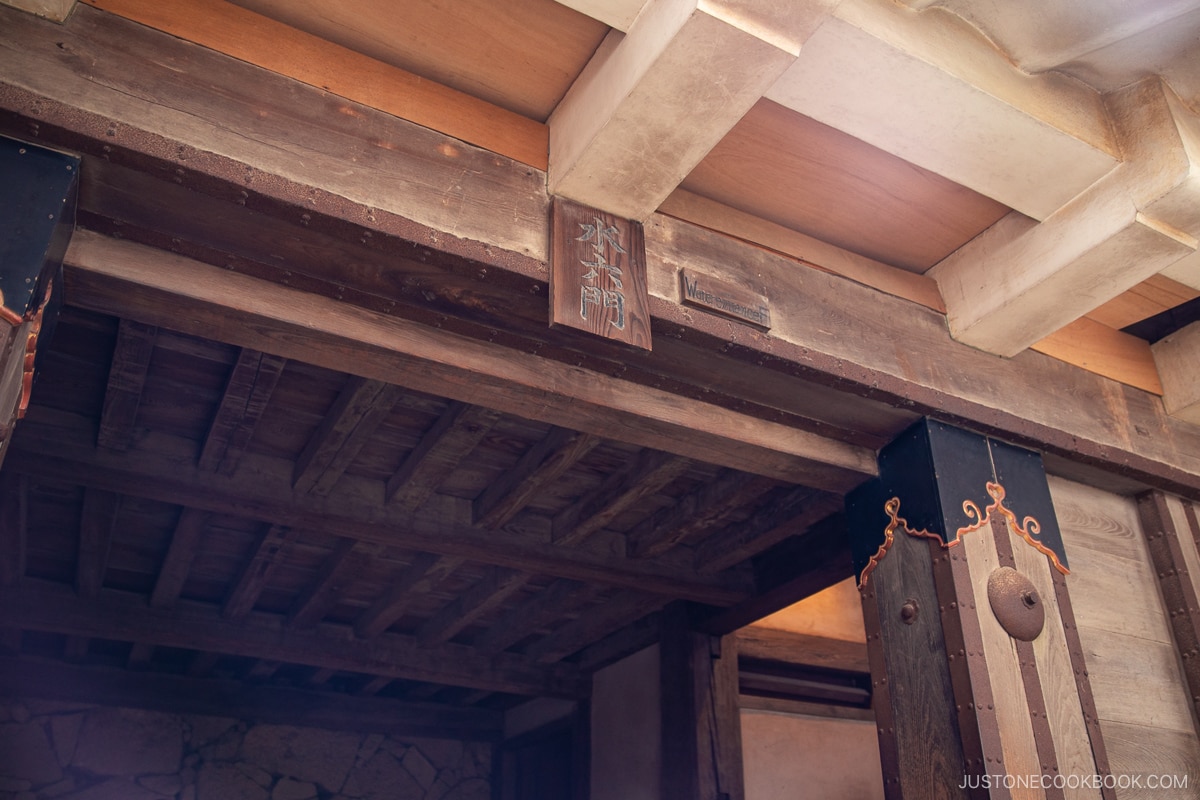
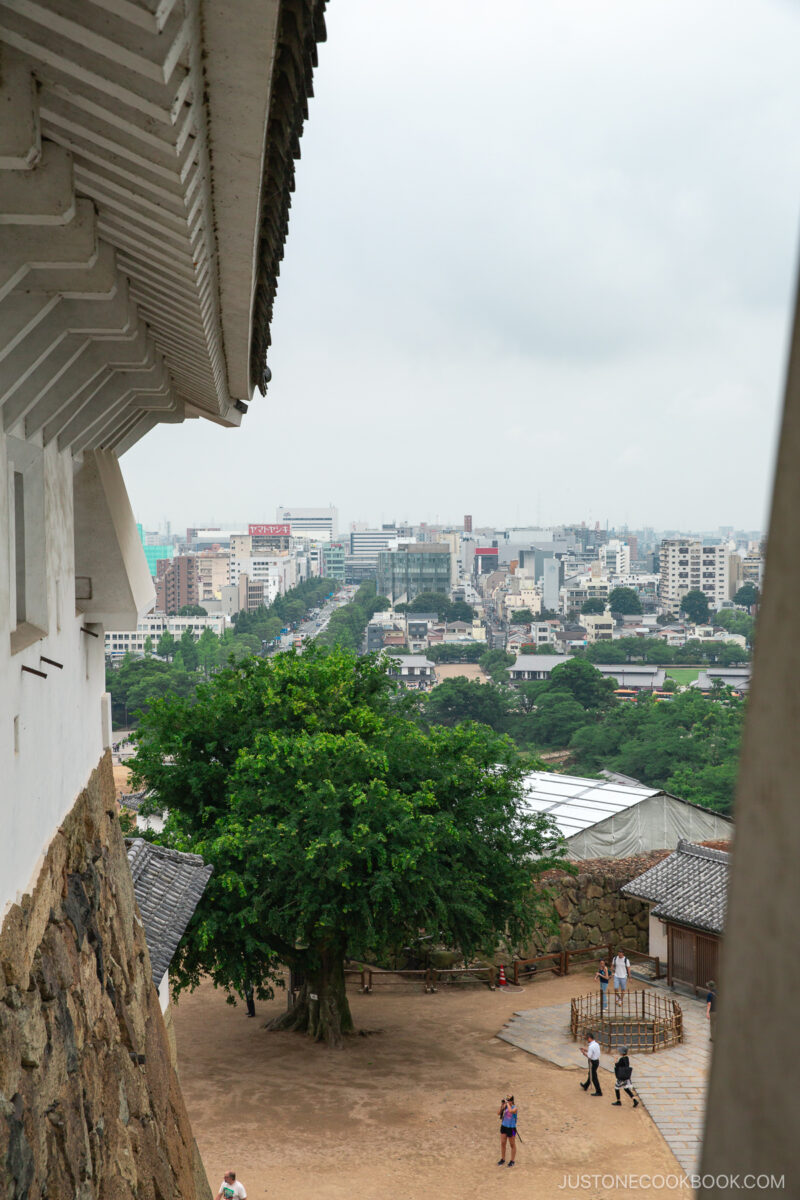
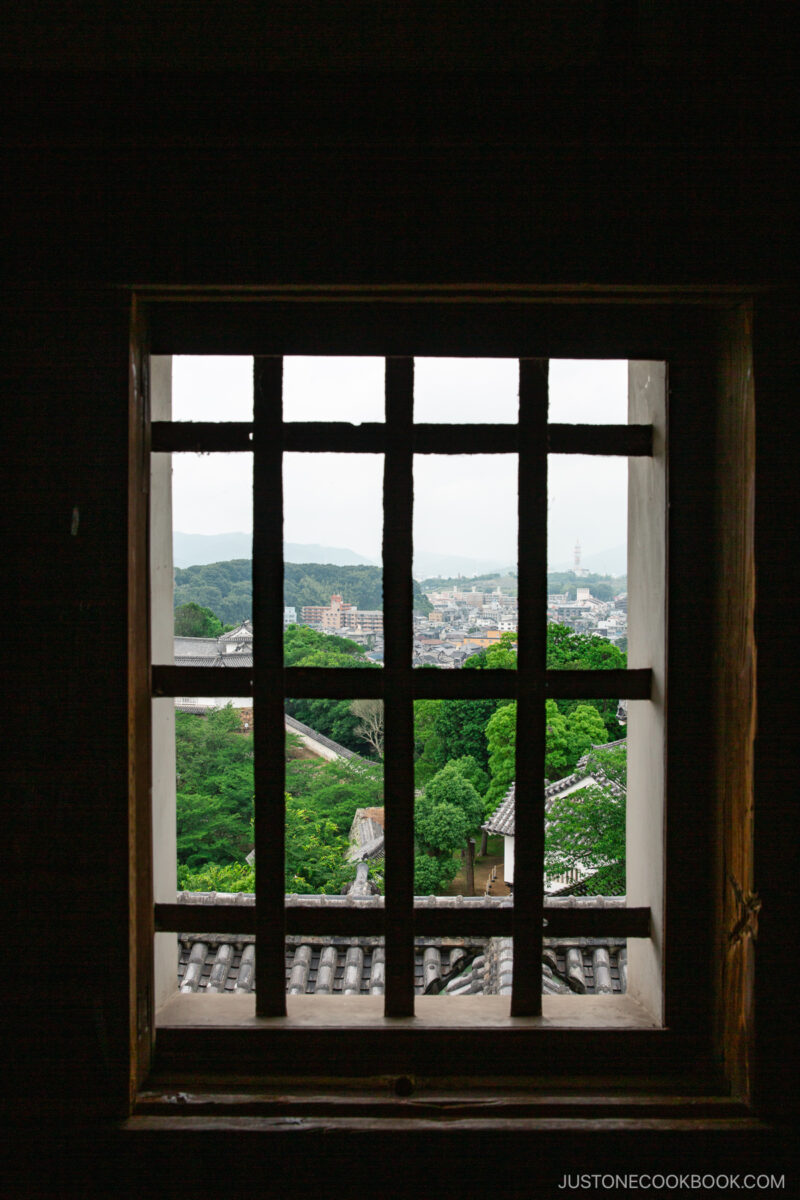

Visitors can learn about the history of the extensive repair done at the Himeji Castle over 6 years. Before 2009, the previous major restoration was completed in 1964. The recent restoration focused on the replacement of roof tiles and walls of the main keep.
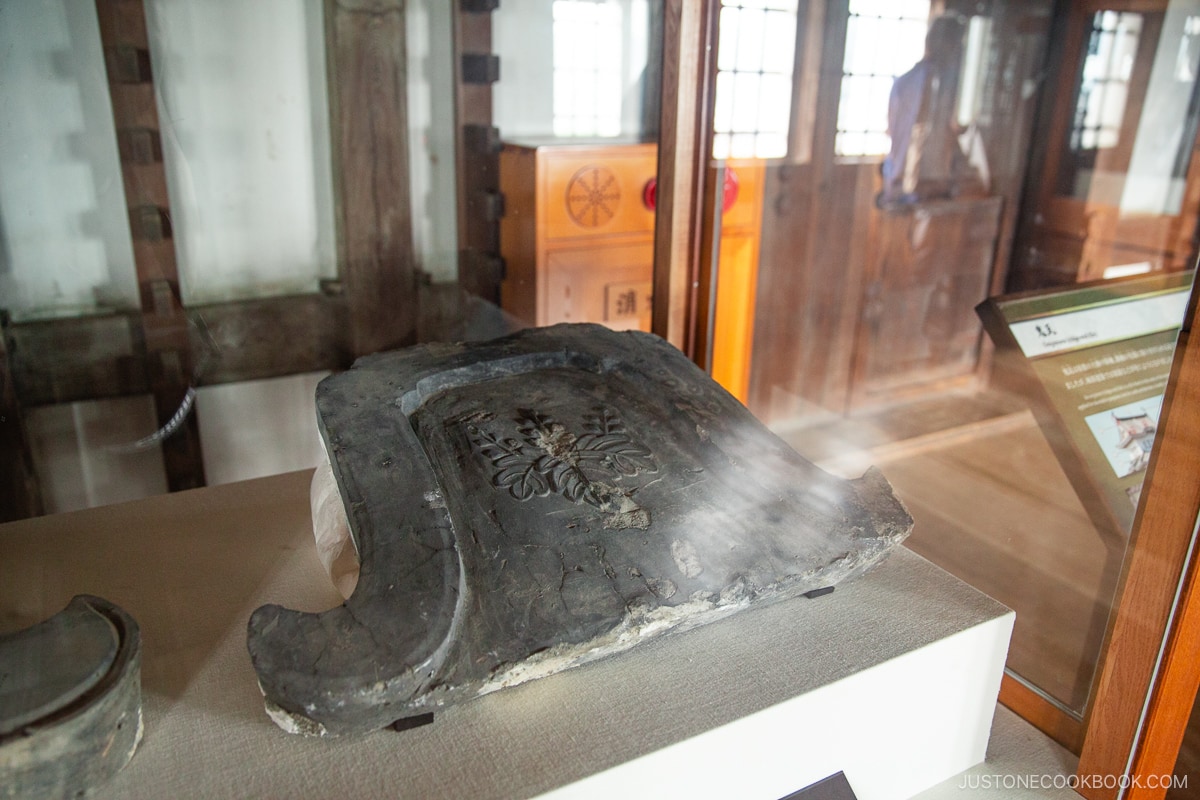
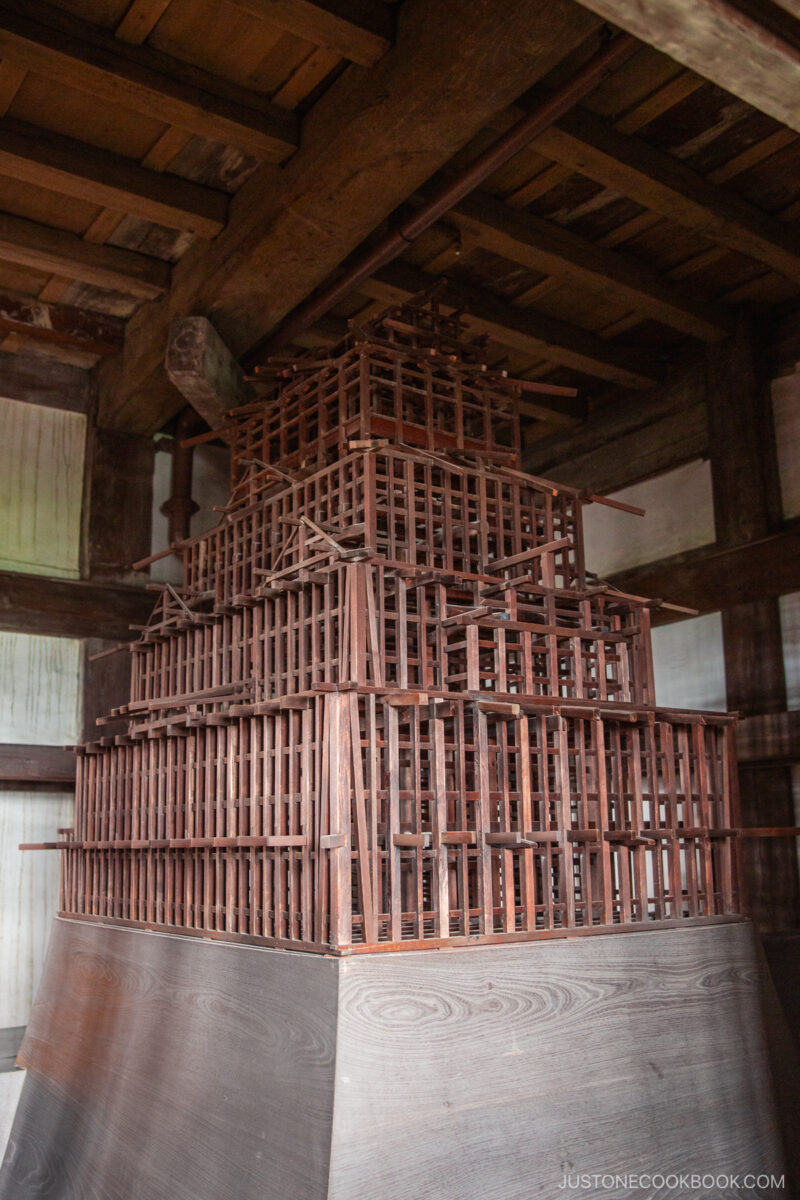
Other displays include a model of the wooden skeleton that supports the castle, demonstrating its resilience against various natural disasters, including the Great Hanshin Earthquake.
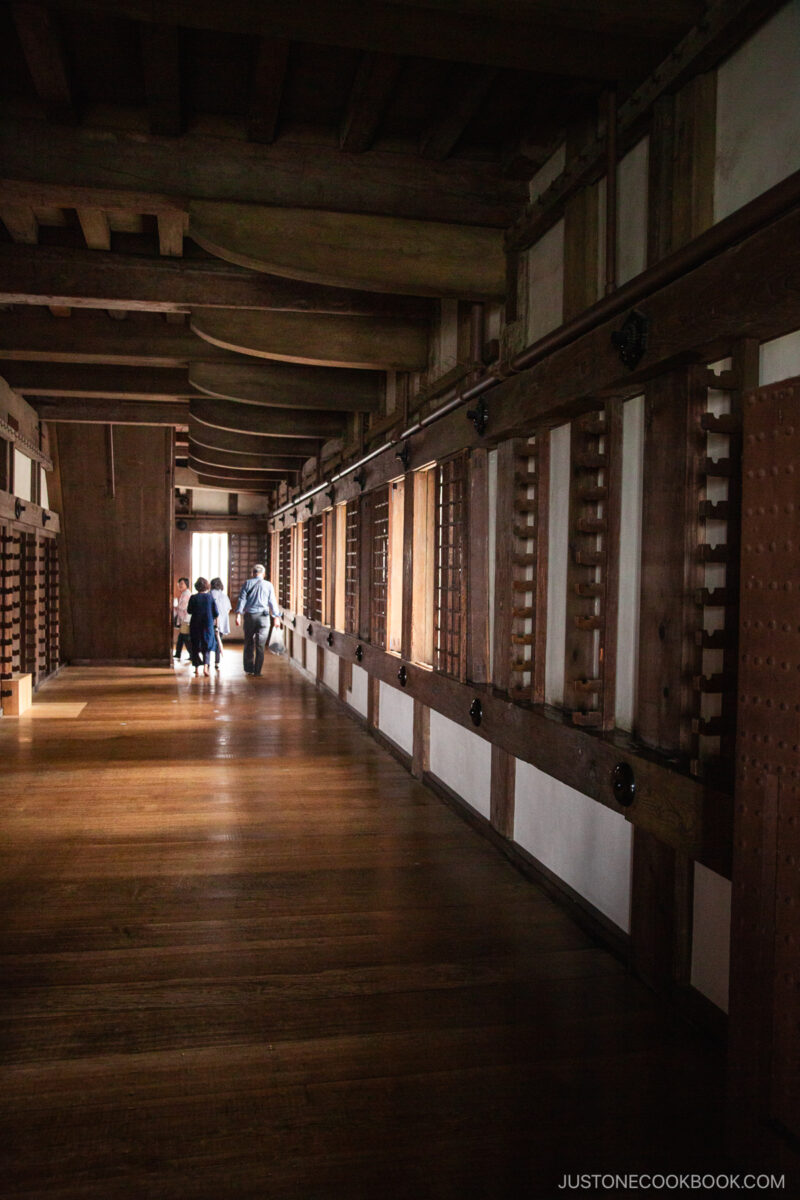
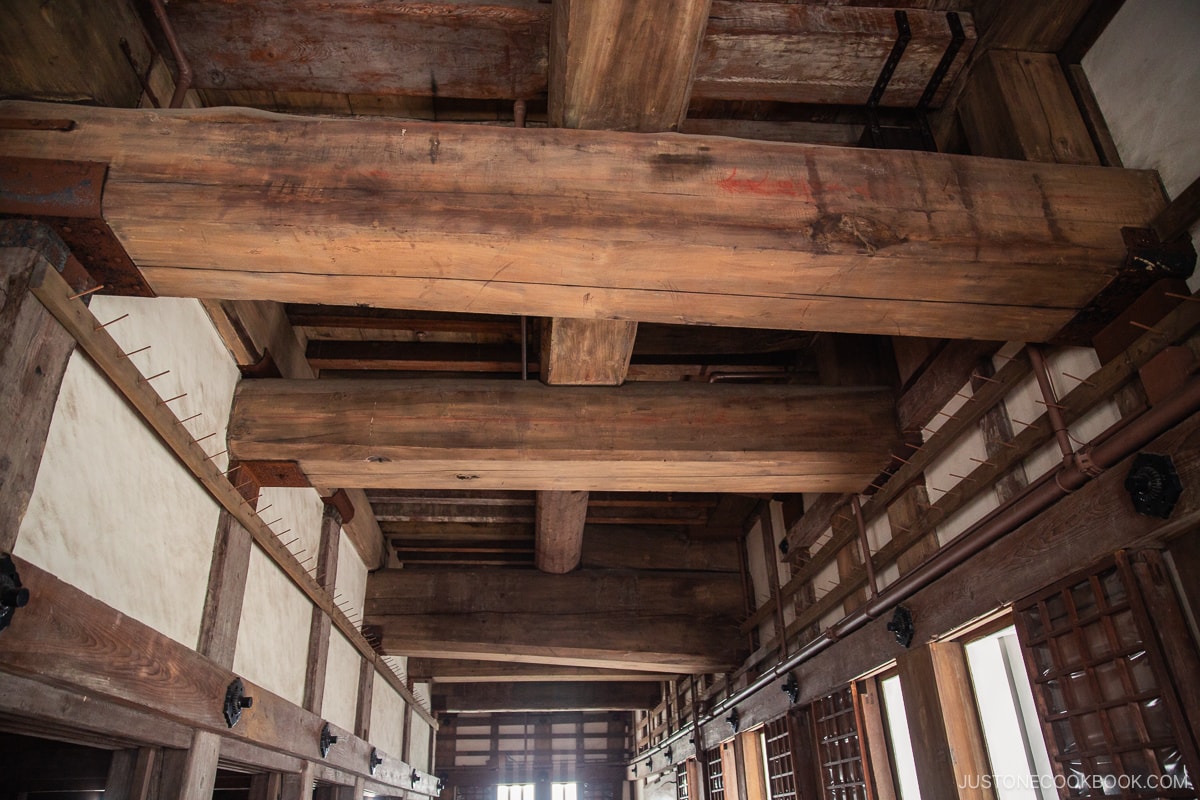
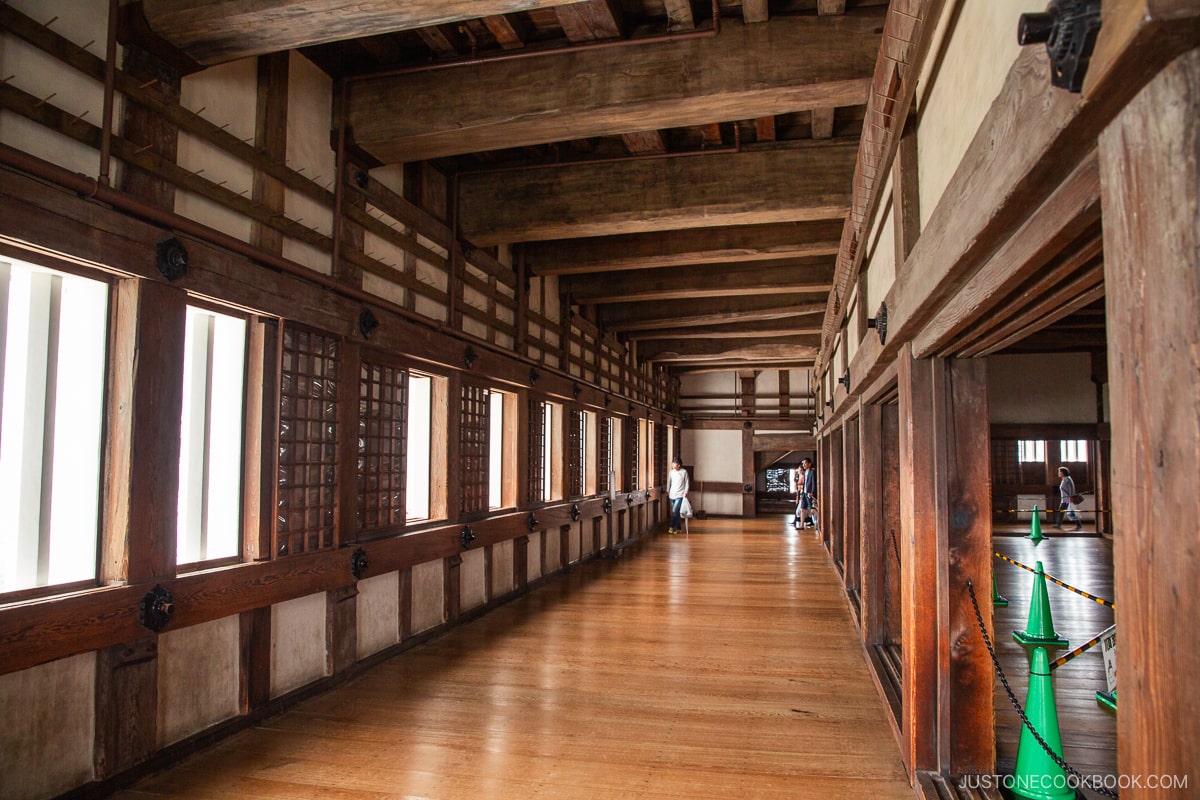
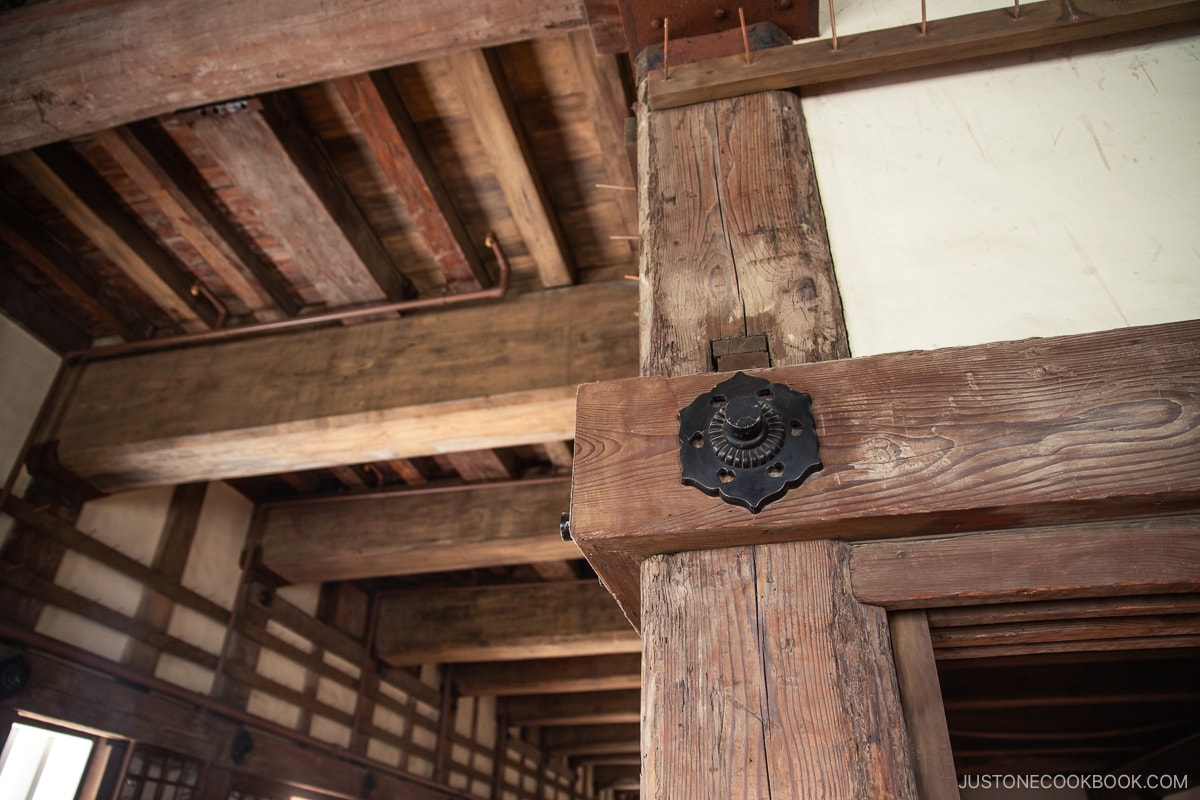
Besides the first floor, there aren’t too many artifacts or castle information on display. Visitors are guided through each of the floors through barriers. A heads-up: there are no restrooms inside the actual castle, so remember to stop by before entering; otherwise, it’s a long way down.
Each floor has a lighted display on the floor plan and a brief explanation of the special features on that floor.
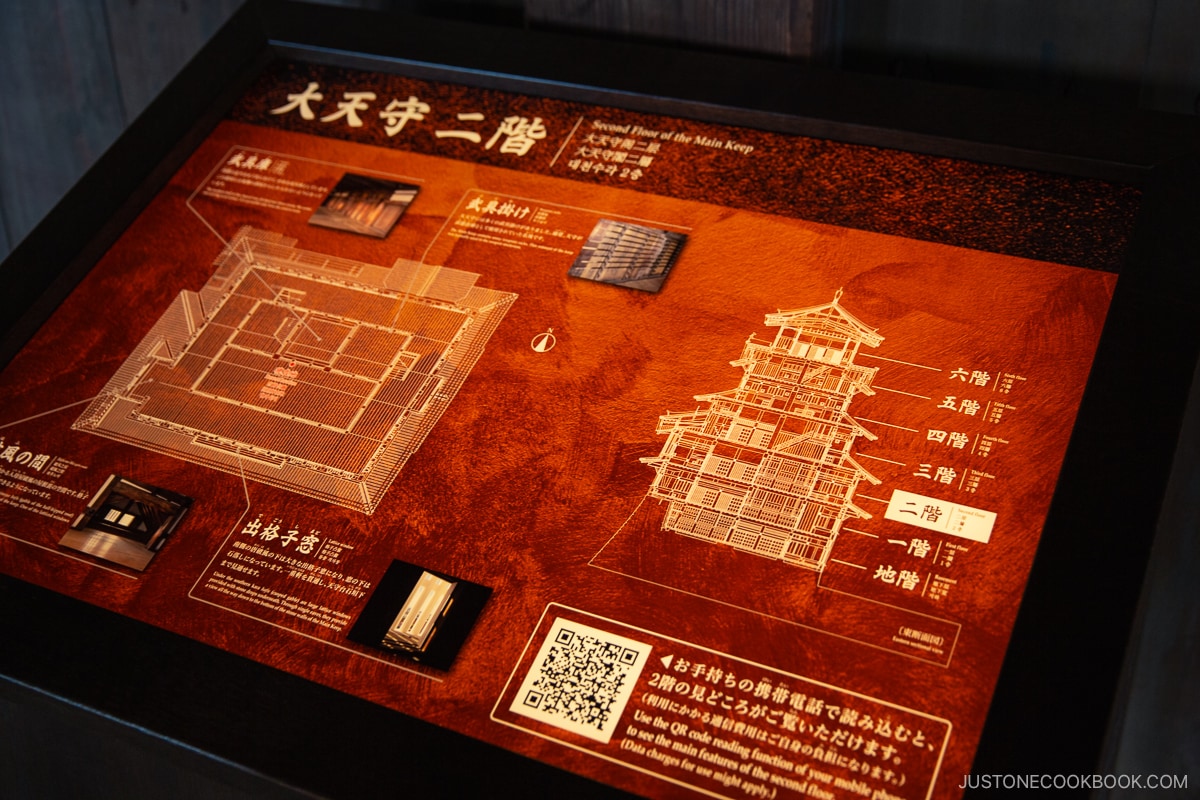
One of the interesting architectural features that stood out to us were the two massive pillars that support the castle, one on the east and another on the west.

Each floor gets progressively smaller as you go higher up. Even though the castle looks like it’s 5 stories from the exterior, it’s actually 6 stories and has a basement floor.
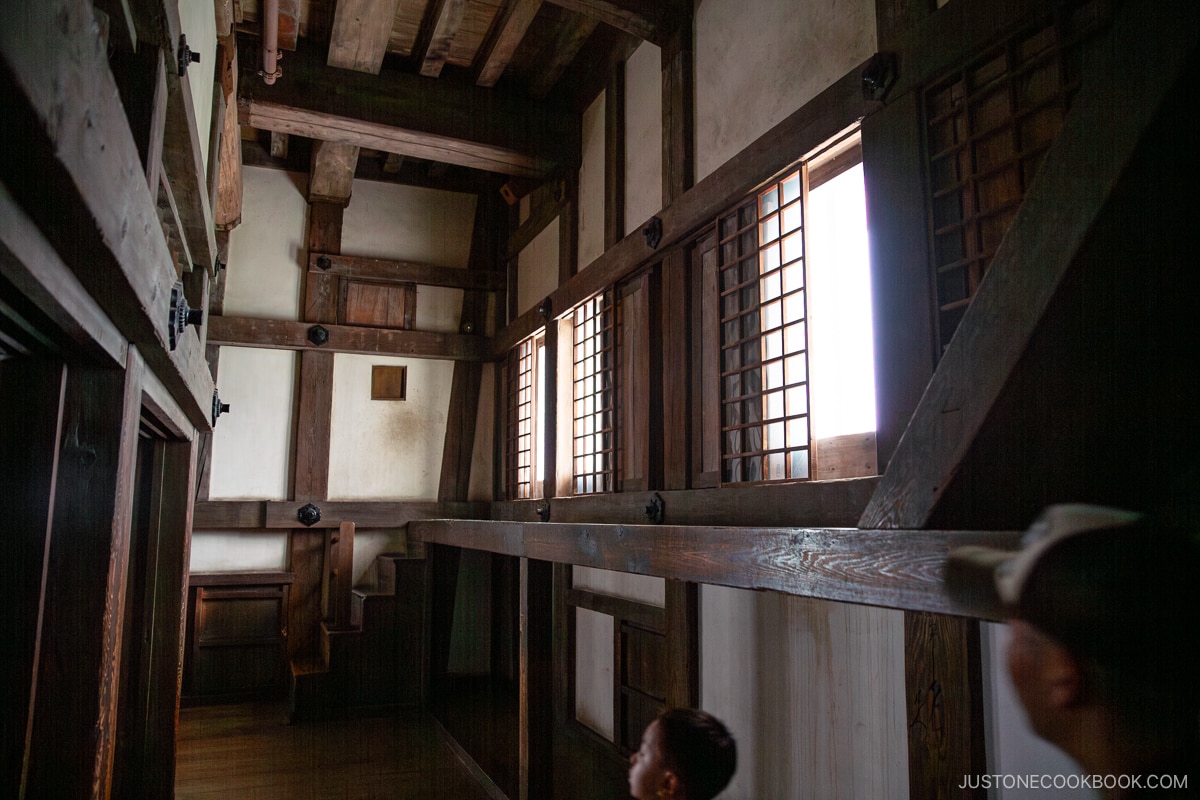
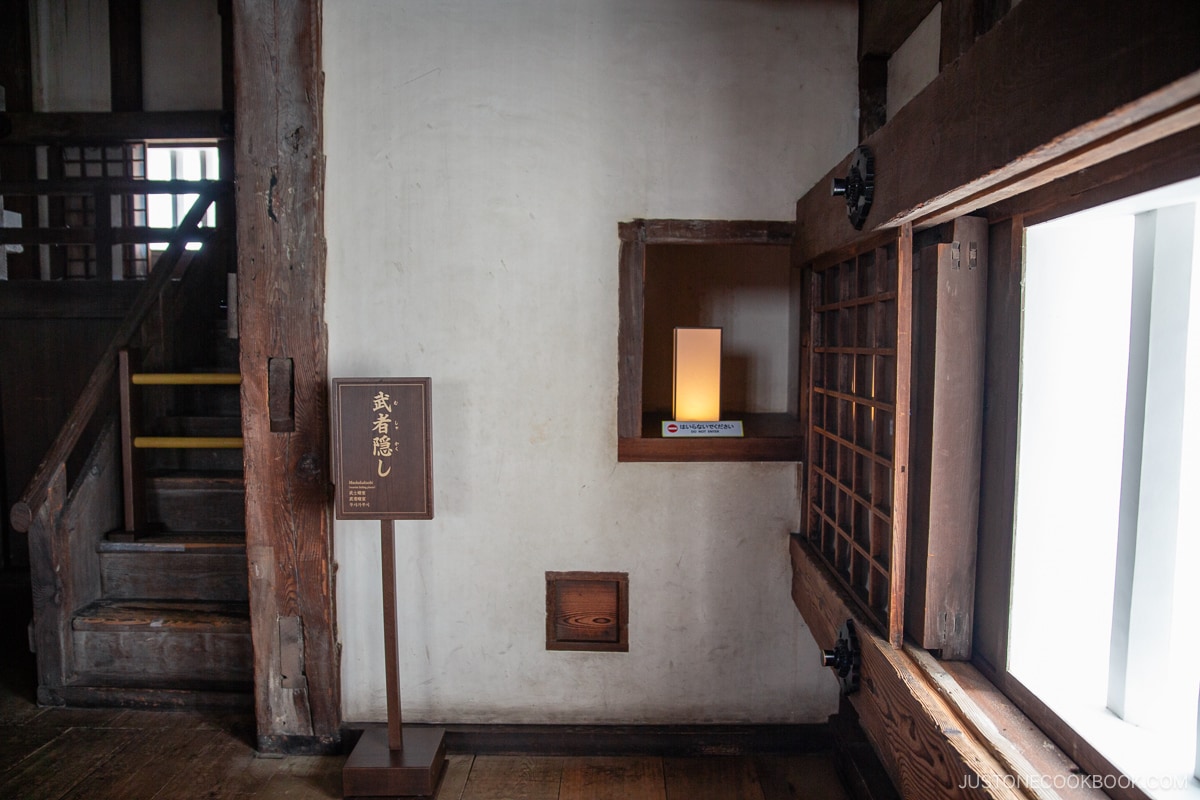
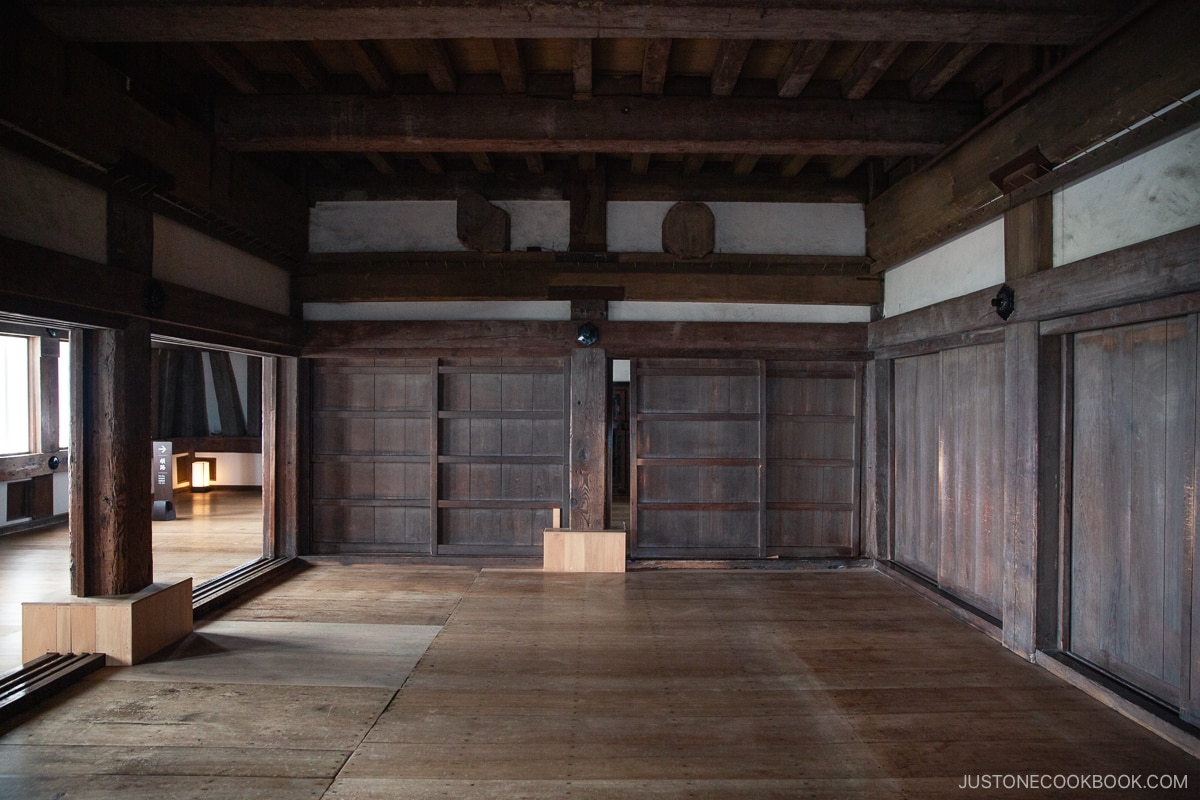
After touring the castle towers, we walked around the castle grounds. One of the interesting features was the Okiku Ido well.
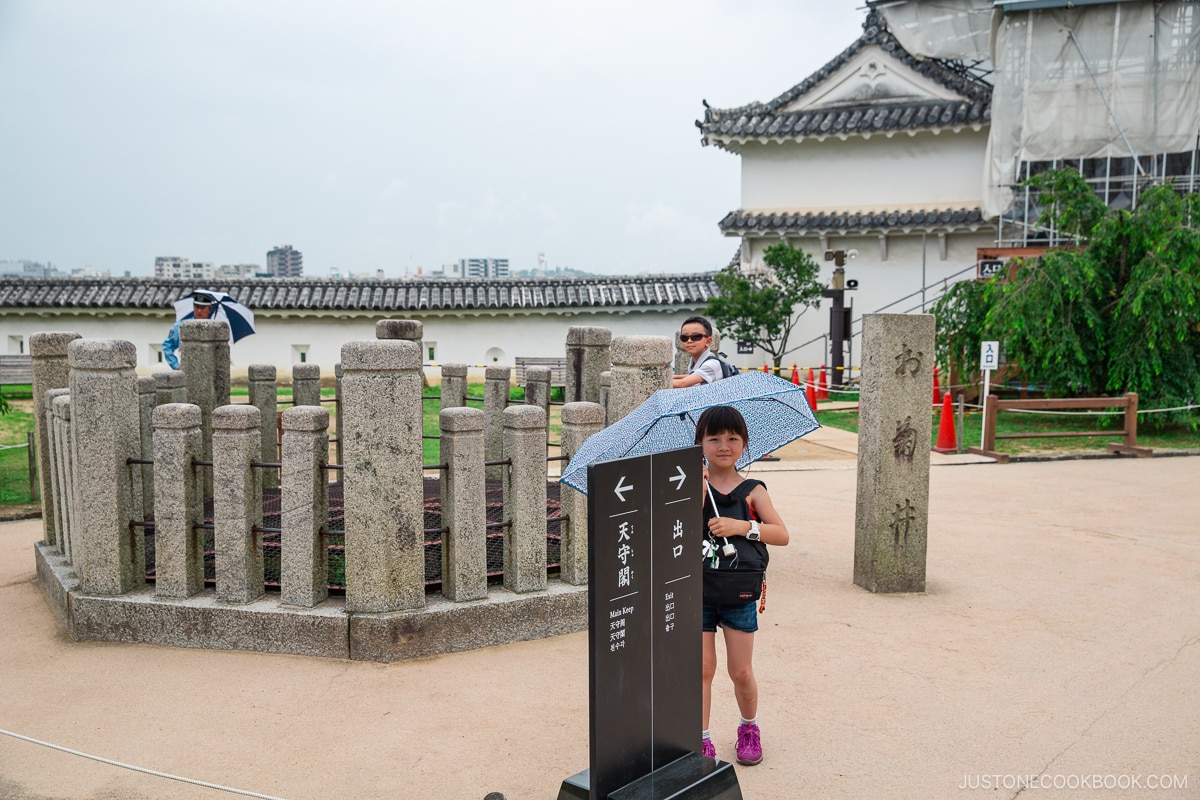
It has been there since the 1500s, and there’s a story of murder and betrayal connected to it. If you are interested in the story, read more here.
Local Specialty Food at Himeji: Sea Eel Sashimi

What is this sea creature, you might ask? Before visiting Himeji Castle, we quickly grabbed a bite at the train station. At most large train stations in Japan, you can find all sorts of restaurants and shops nearby. We visited a seafood shop that had live sea eel (anago 穴子), a local specialty we had never experienced before.
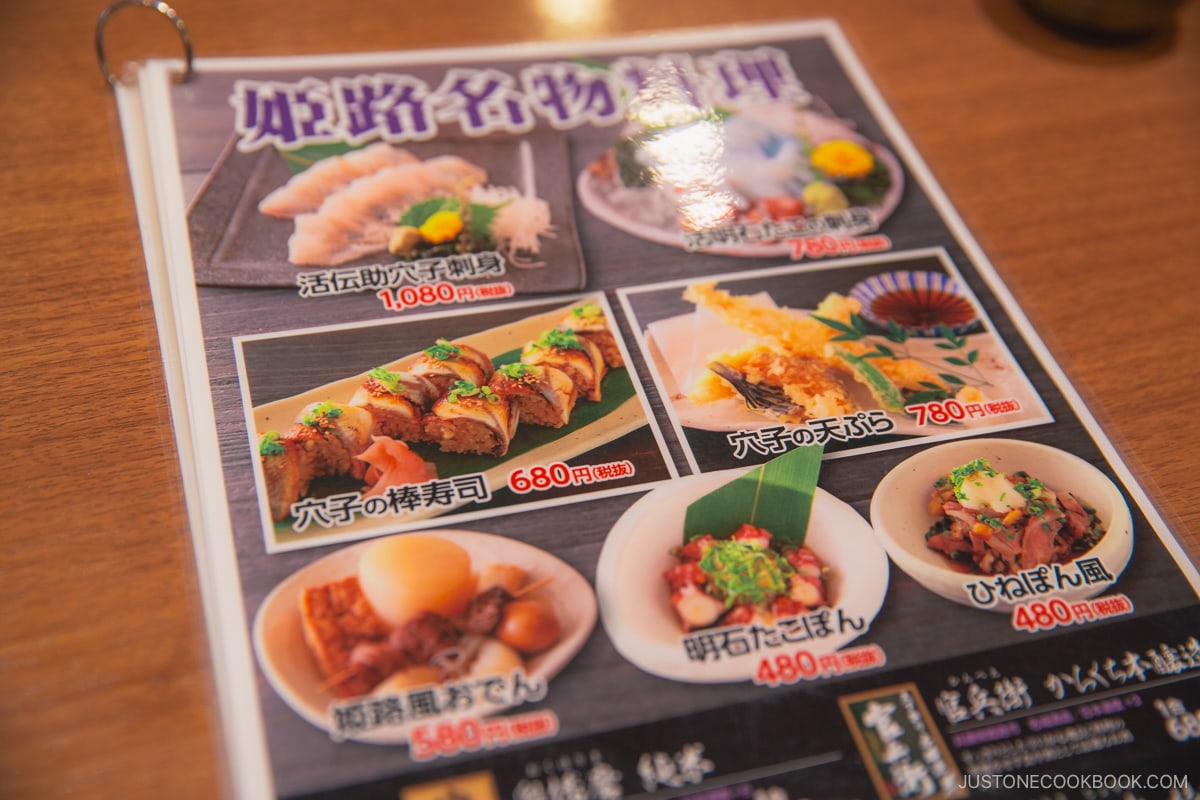
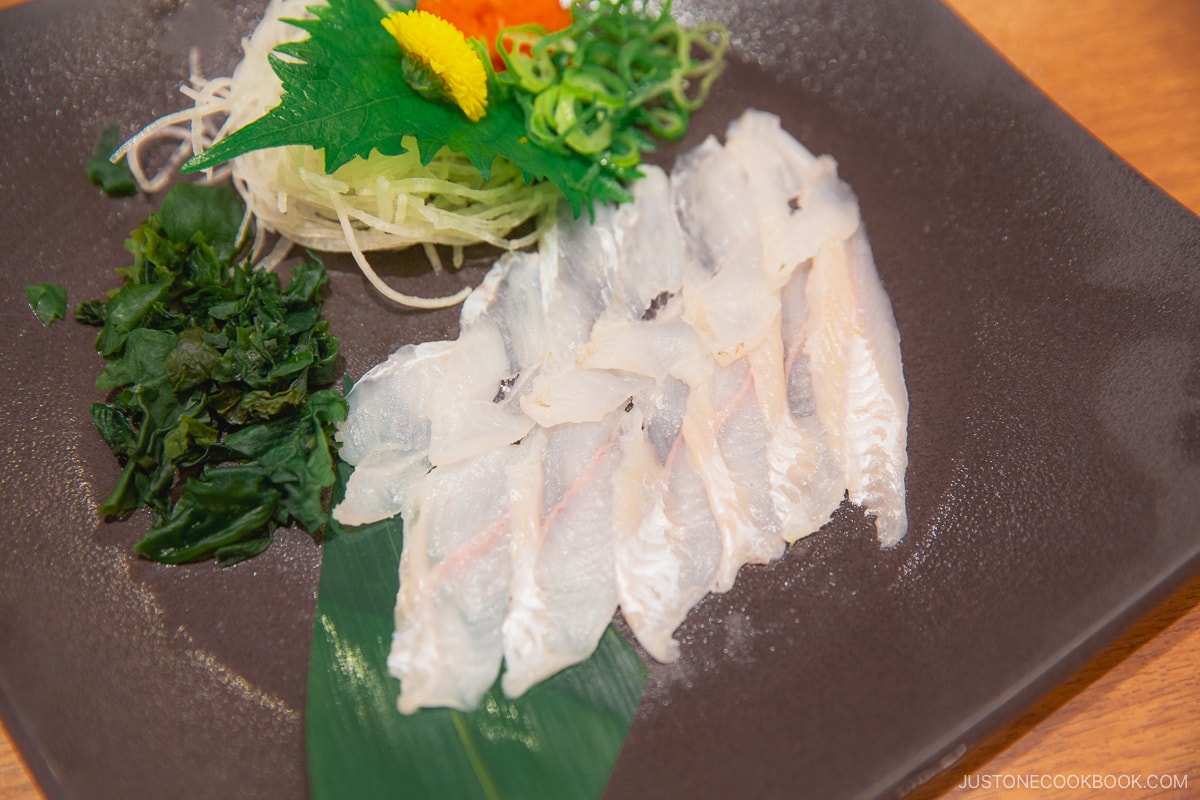
The anago sashimi (I did say fresh!) is thinly sliced into uzusukuri (薄造り), and its texture and flavor were similar to hirame (halibut). It was accompanied by ponzu and was quite delicious; however, there were a lot of small bones we had to pull out.
I hope you enjoyed this quick tour of Himeji Castle. If you haven’t visited an original Japanese Castle, we highly recommend Himeji Castle, Matsumoto Castle, and Matsuyama Castle to your future Japan trip.











Thank you for bringing back memories of my visit to Himeji Castle several years ago where I spent an very enjoyable day exploring. I’ve been fortunate to visit a number of Japanese castles but Himeji remains my favourite.
I went over 20 years ago and had to carry my sleeping infant daughter up those narrowing steep stairs! I just remember there was a stamp to get at each level of the castle and couldn’t imagine how warriors could climb wearing armor and with weaponry in tow. Osaka Castle was an almost disappointment because it was rebuilt and not original and it felt like a museum.
Hi Roy, it must have been quite an adventure, carrying your daughter on your back while navigating the steep stairs!
If you visit Japan in the future, check out Matsumoto Castle or Matsuyama castle. Those are original and interesting to explore.
Hi Nami, did you go to the garden next to Himeji Castle? It requires a separate ticket but it is so worth it. It is gorgeous.
Jo
Hi Jo! Yep, we missed it because it was raining hard by the time we were leaving. 🙁 Next time…
Also there beautiful pastry shops
Thank you so much for sharing your lovely photos and giving us an educational tour of the castle. I thoroughly enjoyed it.
Hi June! Thank you so much for reading! 🙂
Well that was a fun trip through a Japanese castle! Thanks! Looks like the kids had a blast.
A castle is definitely something I’d love to visit in Japan! (Until now all I visit are shops bars and restaurants 😉 ). Thank you for these complete visit and wonderful photos!
Hi Sissi! LOL! Yes, I remember you said no temples, just shop and eating for you. I miss talking to you… 🙂 One day I’ll meet you in Japan!
Unfortunately I didn’t enter this one. I really wanted but due to my pregnancy I felt so week, that I had to go back home. Nice to see it at least on your pictures 🙂
Hi Marta! Oh yeah, that was pre-Mia time! I loved the pictures you took from Japan… Hopefully your family can visit Japan one day. 🙂 xo
Himeji Castle is very beautiful. We visited it too in last May when we were in Japan for our first time.
What I would like to add to your articel is a little warning; the stairs inside are very small/narrow it can get hard to step on them. Also at the stairs there often are wood bars on the ceiling which you easily can bump into with your head. So I would not recommend the castle insides for tall people. Or at least be careful 🙂
We did see many elderly japanese woman (some with walking sticks) mastering these stairs but I would not recommend it for elderly people if they have problems with their feets. (If you can not walk anymore there is no elevator or exit, you will have to follow the road completly up to the top and down again.)
And be aware that you have to carry your shoes around inside the castle (You will have to take them off, They provide bags to carry them)
English is not my native language but I hope I still managed to add some useful information 🙂
Hi Melanie! That is very good tip! I remember it was very steep, and yes narrow! Japanese people back then were even smaller… and it made it harder to travel inside the castle. I am only 5 feet but there are places where I had to duck to go up too. I can’t imagine tall foreigners visiting the castle… you’re right!!!! It’s not just the train doors (I think they all have to bend head to enter). And thank you for adding your tip on carrying the shoes around! Your hands won’t be completely free when you go up or down the stairs. Your information was indeed VERY valuable and thank you for noticing. 🙂
What a magnificent castle. Thank you for sharing your photos of your time there. I remember visiting a Japanese castle in Karatsu when I was there as an exchange student many years ago, even thought it was remodeled, it was so beautiful.
Funny story about the live fish….I remember when my Japanese family took me out to eat on my first night and we went to a Sushi restaurant, the Chef asked me to pick a fish from the tank and then just sliced it up, I couldn’t handle the fact that it was still twitching while it was served on my plate.
Hi Samantha! Thank you for reading my post! Wow you went to Karatsu castle! It’s nice you were in Japan as an exchange student!
It happened to us too. The fish actually jumped out of the original location where it was placed… totally freaked out (even though I’ve seen this way of serving many times that never happened).
Thank you for this great and informative tour!
I visited during the recent restoration (Sept 2013) and it was fascinating to watch the craftsmen working, using traditional methods and tools. And we got to take an elevator to the top because of the construction. Still, I’m looking forward to returning now that it’s fully reopened.
There’s also a beautiful garden next door.
Hi Mimi! Oh really! You could go to the top with an elevator because of the construction? COOL! It was a looooooong way to go up on foot. 😀 It was raining so much by the time we were leaving, so guess what, we had to skip the beautiful garden (hence no pictures). We have to go back one day too… 🙂
P.S. You have a COOL website! I collect chopsticks holder too mostly for fun and props for photo shooting. 😀